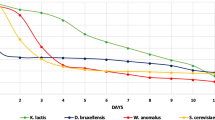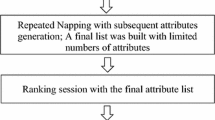Abstract
Wine yeast strains Torulaspora delbrueckii, Saccharomyces bayanus and an osmo-ethanol tolerant Saccharomyces cerevisiae strain isolated in a Pedro Ximenez grape must have been used as starter cultures for mead production without addition of nitrogen assimilable sources. Significant differences on the fermentation kinetics, major volatile compound (MVC) contents and in organoleptic properties (OP) were obtained. A Multivariate Analysis (MVA) carried out with the contents in the six key compounds, acetaldehyde, 1-propanol, isobutanol, acetoin, 2,3-butanediol (levo) and diethyl succinate, allows to obtain a chemical profile or fingerprint very useful to differentiate each mead. By subjecting these MVC to a principal component analysis, two PCs were obtained that explain the 85.3% of variance and group the meads according the yeast used. Meads obtained with T. delbrueckii have a low ethanol, high residual sugar content and preserve the primary aroma of honey. It was concluded from a sensorial evaluation that the most suitable yeast that produces the sweet type of multifloral honey mead is T. delbrueckii, while S. bayanus is suitable for dry meads.




Similar content being viewed by others
Abbreviations
- MSC:
-
Multiple sample comparison
- MVA:
-
Multiple variable analysis
- MVC:
-
Major volatile compounds
- PCA:
-
Principal component analysis
References
Pereira AP, Oliveira JM, Mendes-Ferreira A, Estevinho LM, Mendes-Faia A (2017) Mead and other fermented beverages. In: Pandey A, Sanromán M, Du G, Soccol C, Dussap C (eds) Current developments in biotechnology and bioengineering. Elsevier, Amsterdam, pp 407–434. https://doi.org/10.1016/B978-0-444-63666-9.00014-5(Chapter 14)
Pereira AP, Mendes-Ferreira A, Oliveira JM, Estevinho LM, Mendes-Faia A (2015) Mead production: effect of nitrogen supplementation on growth, fermentation profile and aroma formation by yeasts in mead fermentation. J Inst Brew 121:122–128
Pereira AP, Dias T, Andrade J, Ramalhosa E, Letícia M, Estevinho LM (2009) Mead production: selection and characterization assays of Saccharomyces cerevisiae strains. Food Chem Toxicol 47:2057–2063
Mendes-Ferreira A, Cosme F, Barbosa C, Falco V, Ines A, Mendes-Faia A (2010) Optimization of honey-wort preparation and alcoholic fermentation by Saccharomyces cerevisiae for mead production. Int J Food Microbiol 144:193–198
Pereira AP, Mendes-Ferreira A, Oliveira JM, Estevinho LM, Mendes-Faia A (2013) High-cell-density fermentation of Saccharomyces cerevisiae for the optimisation of mead production. Food Microbiol 33:114–123
Carrau FM, Medina K, Farina L, Boido E, Henschke PA, Dellacassa E (2008) Production of fermentation aroma compounds by Saccharomyces cerevisiae wine yeasts: effects of yeast assimilable nitrogen on two model strains. FEMS Yeast Res 8:1196–1207
Bely M, Stoeckle P, Masneuf-Pomarède I, Dubourdieu D (2008) Impact of mixed Torulaspora delbrueckii–Saccharomyces cerevisiae cultures on high-sugar fermentation. Int J Food Microbiol 122:312–320
Belda I, Navascués E, Marquina D, Santos A, Calderon F, Benito S (2015) Dynamic analysis of physiological properties of Torulaspora delbrueckii in wine fermentations and its incidence on wine. Appl Microbiol Biotechnol 99:1911–1922
Velázquez R, Zamora E, Álvarez ML, Hernández LM, Ramírez M (2015) Effects of new Torulaspora delbrueckii killer yeasts on the must fermentation kinetics and aroma compounds of white table wine. Front Microbiol. https://doi.org/10.3389/fmicb.2015.01222
Benito S (2018) The impact of Torulaspora delbrueckii yeast in winemaking. Appl Microbiol Biotechnol 102:3081–3094. https://doi.org/10.1007/s00253-018-8849-0
Barry JP, Metz MS, Hughey J, Quirk A, Bochman ML (2018) Two novel strains of Torulaspora delbrueckii isolated from the honey bee microbiome and their use in honey fermentation. Fermentation 4:1–11. https://doi.org/10.3390/fermentation4020022
Ruirui L, Yuxia SY (2019) Effects of honey variety and non-Saccharomyces cerevisiae on the flavor volatiles of mead. J Am Soc Brew Chem 77:40–53. https://doi.org/10.1080/03610470.2018.1546072
Ramalhosa E, Gomes T, Pereira AP, Dias T, Andrade J, Letícia M, Estevinho LM (2011) Mead production: tradition versus modernity. In: Jackson RS (ed) Advances in food and nutrition research, vol 63. Academic Press (Elsevier), Burlington, pp 101–118 (ISBN 978-0-12-384927-4)
CEE (1990) Diario Oficial de las Comunidades Europeas. Diario L-272. Ed Mundi-Prensa, Springer, Madrid
Shively CE, Henick-Kling T (2001) Comparison of two procedures for assay of free amino nitrogen. Am J Enol Vitic 52:400–401
Filipe-Ribeiro L, Mendes-Faia A (2007) Validation and comparison of analytical methods used to evaluate the nitrogen status of grape juice. Food Chem 100:1272–1277
Peinado RA, Moreno JA, Muñoz D, Medina M, Moreno J (2004) Gas chromatographic quantification of major volatile compounds and polyols in wine by direct injection. J Agric Food Chem 52:6389–6393
Vararu F, Moreno-García J, Zamfir C, Cotea VV, Moreno J (2016) Selection of aroma compounds for the differentiation of wines obtained by fermenting musts with starter cultures of commercial yeast strains. Food Chem 15:373–381. https://doi.org/10.1016/j.foodchem.2015.10.111
UNE 87-020-93 (1997) Análisis sensorial. AENOR, Madrid
Cabrera J, Moreno J, Ortega JM, Medina M (1988) Formation of ethanol, higher alcohols, esters, and terpenes by five yeast strains in musts from Pedro Ximénez grapes in various degrees of ripeness. Am J Enol Vitic 39(4):283–287
Moreno J, Millán C, Ortega JM, Medina M (1991) Analytical differentiation of wine fermentations using pure and mixed yeast cultures. J Ind Microbiol 7:181–189. https://doi.org/10.1007/BF01575881
García-Martínez T, Bellincontro A, López de Lerma MN, Peinado RA, Mauricio JC, Mencarelli F, Moreno J (2011) Discrimination of sweet wines partially fermented by two osmo-ethanol-tolerant yeasts by gas chromatographic analysis and electronic nose. Food Chem. 127:1391–1396. https://doi.org/10.1016/j.foodchem.2011.01.130
Roldán A, van Muiswinkel GCJ, Lasanta C, Palacios V, Caro I (2011) Influence of pollen addition on mead elaboration: physicochemical and sensory characteristics. Food Chem 126:574–582
Rodrigues de Sousa H, Spencer-Martins I, Gonçalves P (2004) Differential regulation by glucose and fructose of a gene encoding a specific fructose/H+ symporter in Saccharomyces sensu stricto yeasts. Yeast. 21:519–530
Moreno J, Peinado RA (2012) Enological chemistry. Academic Press (Elsevier), San Diego (ISBN 9780123884381)
Pérez RA, Iglesias MT, Pueyo E, Gonzalez M, de Lorenzo C (2007) Amino acid composition and antioxidant capacity of Spanish honeys. J Agric Food Chem 24:360–365
Sroka P, Tuszynski T (2007) Changes in organic acid contents during mead wort fermentation. Food Chem 104:1250–1257
Ugliano M, TravisI B, Francis L, Henschke PA (2010) Volatile composition and sensory properties of Shiraz wines as affected by nitrogen supplementation and yeast species: rationalizing nitrogen modulation of wine aroma. J Agric Food Chem 58(23):12417–12425. https://doi.org/10.1021/jf1027137
Swiegers J, Bartowsky E, Henschke P, Pretorius I (2005) Yeast and bacterial modulation of wine aroma and flavour. Aust J Grape Wine Res 11:139–173. https://doi.org/10.1111/j.1755-0238.2005.tb00285.x
Etschmann M, Bluemke W, Sell D, Schrader J (2002) Biotechnological production of 2-phenylethanol. Appl Microbiol Biotechnol 59(1):1–8. https://doi.org/10.1007/s00253-002-0992-x
Sabon I, de Revel G, Kotseridis Y, Bertrand A (2002) Determination of volatile compounds in grenache wines in relation with different terroirs in the Rhone Valley. J Agric Food Chem 50:6341–6345
Bartowsky EJ, Pretorius IS (2009) Microbial formation and modification of flavor and off-flavor compounds in wine. In: König H, Unden G, Fröhlich J (eds) Biology of microorganisms on grapes, in must and in wine. Springer, Berlin
Šmogrovičová D, Nádasky P, Tandlich R, Wilhelmi BS, Cambray G (2012) Analytical and aroma profiles of Slovak and South African meads. Czech J Food Sci 30(3):241–246. https://doi.org/10.17221/113/2011-CJFS
Sumby KM, Grbin PR, Jiranek V (2010) Microbial modulation of aromatic esters in wine: current knowledge and future prospects. Food Chem 121:1–16. https://doi.org/10.1016/j.foodchem.2009.12.004
Dourtoglou V, Antonopoulos A, Dourtoglou T, Lalas S (2014) Discrimination of varietal wines according to their volatiles. Food Chem 159:181–187. https://doi.org/10.1016/j.foodchem.2014.03.032
Bénes I, Furdíková K, Šmogrovičová D (2015) Influence of Saccharomyces cerevisiae strain on the profile of volatile organic compounds of blossom honey mead. Czech J Food Sci 33(4):334–339. https://doi.org/10.17221/48/2015-CJFS
Vilanova M, Oliveira JM (2012) Application of gas chromatography on the evaluation of grape and wine aroma in Atlantic viticulture (NW Iberian Peninsula). In: Salih B (ed) Gas chromatography in plant science, wine technology, toxicology and some specific applications. pp 109–146. https://www.intechopen.com/books/gas-chromatography-in-plant-science-wine-technology-toxicology-and-some-specific-applications/application-of-gas-chromatography-on-the-evaluation-of-grape-and-wine-aroma-in-atlantic-viticulture-. Accessed May 2019 (Chapter 7, ISBN 978-953-51-0127-7)
Iglesias A, Pascoal A, Choupina AB, Carvalho CA, Feás C, Estevinho LM (2014) Developments in the fermentation process and quality improvement strategies for mead production. Molecules 19(8):12577–12590. https://doi.org/10.3390/molecules190812577
Official Website of the Wine Aroma Wheel. https://www.winearomawheel.com/. Accessed Mar 2019
Acknowledgements
The authors thank Minami Ogawa for her assistance with English language editing. This research was funded by the XXIII Programa Propio de Fomento de la Investigación (MOD 4.2. SINERGIAS, Ref. XXIII PP Mod. 4.2 de la Universidad de Córdoba (Spain).
Author information
Authors and Affiliations
Corresponding author
Ethics declarations
Conflict of interest
The authors declare that they have no competing interest.
Ethical approval
This article does not contain any studies with human participants performed by any of the authors.
Additional information
Publisher's Note
Springer Nature remains neutral with regard to jurisdictional claims in published maps and institutional affiliations.
Rights and permissions
About this article
Cite this article
Sottil, C., Salor-Torregrosa, J.M., Moreno-Garcia, J. et al. Using Torulaspora delbrueckii, Saccharomyces cerevisiae and Saccharomyces bayanus wine yeasts as starter cultures for fermentation and quality improvement of mead. Eur Food Res Technol 245, 2705–2714 (2019). https://doi.org/10.1007/s00217-019-03384-z
Received:
Revised:
Accepted:
Published:
Issue Date:
DOI: https://doi.org/10.1007/s00217-019-03384-z




